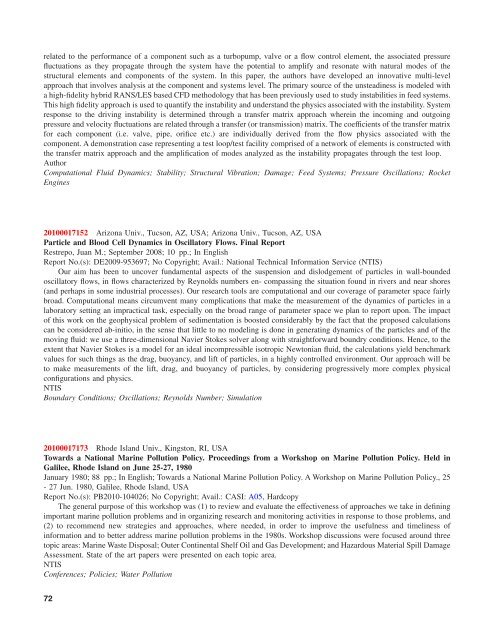NASA Scientific and Technical Aerospace Reports - The University ...
NASA Scientific and Technical Aerospace Reports - The University ...
NASA Scientific and Technical Aerospace Reports - The University ...
Create successful ePaper yourself
Turn your PDF publications into a flip-book with our unique Google optimized e-Paper software.
elated to the performance of a component such as a turbopump, valve or a flow control element, the associated pressure<br />
fluctuations as they propagate through the system have the potential to amplify <strong>and</strong> resonate with natural modes of the<br />
structural elements <strong>and</strong> components of the system. In this paper, the authors have developed an innovative multi-level<br />
approach that involves analysis at the component <strong>and</strong> systems level. <strong>The</strong> primary source of the unsteadiness is modeled with<br />
a high-fidelity hybrid RANS/LES based CFD methodology that has been previously used to study instabilities in feed systems.<br />
This high fidelity approach is used to quantify the instability <strong>and</strong> underst<strong>and</strong> the physics associated with the instability. System<br />
response to the driving instability is determined through a transfer matrix approach wherein the incoming <strong>and</strong> outgoing<br />
pressure <strong>and</strong> velocity fluctuations are related through a transfer (or transmission) matrix. <strong>The</strong> coefficients of the transfer matrix<br />
for each component (i.e. valve, pipe, orifice etc.) are individually derived from the flow physics associated with the<br />
component. A demonstration case representing a test loop/test facility comprised of a network of elements is constructed with<br />
the transfer matrix approach <strong>and</strong> the amplification of modes analyzed as the instability propagates through the test loop.<br />
Author<br />
Computational Fluid Dynamics; Stability; Structural Vibration; Damage; Feed Systems; Pressure Oscillations; Rocket<br />
Engines<br />
20100017152 Arizona Univ., Tucson, AZ, USA; Arizona Univ., Tucson, AZ, USA<br />
Particle <strong>and</strong> Blood Cell Dynamics in Oscillatory Flows. Final Report<br />
Restrepo, Juan M.; September 2008; 10 pp.; In English<br />
Report No.(s): DE2009-953697; No Copyright; Avail.: National <strong>Technical</strong> Information Service (NTIS)<br />
Our aim has been to uncover fundamental aspects of the suspension <strong>and</strong> dislodgement of particles in wall-bounded<br />
oscillatory flows, in flows characterized by Reynolds numbers en- compassing the situation found in rivers <strong>and</strong> near shores<br />
(<strong>and</strong> perhaps in some industrial processes). Our research tools are computational <strong>and</strong> our coverage of parameter space fairly<br />
broad. Computational means circumvent many complications that make the measurement of the dynamics of particles in a<br />
laboratory setting an impractical task, especially on the broad range of parameter space we plan to report upon. <strong>The</strong> impact<br />
of this work on the geophysical problem of sedimentation is boosted considerably by the fact that the proposed calculations<br />
can be considered ab-initio, in the sense that little to no modeling is done in generating dynamics of the particles <strong>and</strong> of the<br />
moving fluid: we use a three-dimensional Navier Stokes solver along with straightforward boundry conditions. Hence, to the<br />
extent that Navier Stokes is a model for an ideal incompressible isotropic Newtonian fluid, the calculations yield benchmark<br />
values for such things as the drag, buoyancy, <strong>and</strong> lift of particles, in a highly controlled environment. Our approach will be<br />
to make measurements of the lift, drag, <strong>and</strong> buoyancy of particles, by considering progressively more complex physical<br />
configurations <strong>and</strong> physics.<br />
NTIS<br />
Boundary Conditions; Oscillations; Reynolds Number; Simulation<br />
20100017173 Rhode Isl<strong>and</strong> Univ., Kingston, RI, USA<br />
Towards a National Marine Pollution Policy. Proceedings from a Workshop on Marine Pollution Policy. Held in<br />
Galilee, Rhode Isl<strong>and</strong> on June 25-27, 1980<br />
January 1980; 88 pp.; In English; Towards a National Marine Pollution Policy. A Workshop on Marine Pollution Policy., 25<br />
- 27 Jun. 1980, Galilee, Rhode Isl<strong>and</strong>, USA<br />
Report No.(s): PB2010-104026; No Copyright; Avail.: CASI: A05, Hardcopy<br />
<strong>The</strong> general purpose of this workshop was (1) to review <strong>and</strong> evaluate the effectiveness of approaches we take in defining<br />
important marine pollution problems <strong>and</strong> in organizing research <strong>and</strong> monitoring activities in response to those problems, <strong>and</strong><br />
(2) to recommend new strategies <strong>and</strong> approaches, where needed, in order to improve the usefulness <strong>and</strong> timeliness of<br />
information <strong>and</strong> to better address marine pollution problems in the 1980s. Workshop discussions were focused around three<br />
topic areas: Marine Waste Disposal; Outer Continental Shelf Oil <strong>and</strong> Gas Development; <strong>and</strong> Hazardous Material Spill Damage<br />
Assessment. State of the art papers were presented on each topic area.<br />
NTIS<br />
Conferences; Policies; Water Pollution<br />
72

















